Business Accounting Report on Trial Balance, Adjustments, and Closing
VerifiedAdded on 2023/06/04
|13
|1830
|405
Report
AI Summary
This business accounting report provides a comprehensive overview of key accounting concepts and procedures. It begins by defining the trial balance, explaining its purpose in ensuring the accuracy of general ledger entries, and highlighting its importance, particularly in manual accounting systems. The report then delves into adjustment journal entries, emphasizing their role in adhering to the accrual concept and matching principle, as well as correcting accounting errors. It discusses the different types of adjusting entries and their significance in updating accounts for accurate financial reporting. The report further examines the adjusted trial balance, outlining its function in verifying the accuracy of ledger entries after adjustments and its use in preparing financial statements. Finally, it contrasts adjusting and closing journal entries, detailing their distinct purposes and timing within the accounting cycle. The report concludes with a reference list of sources.

Running head: BUSINESS ACCOUNTING
Business accounting
Name of the student
Name of the university
Student ID
Author note
Business accounting
Name of the student
Name of the university
Student ID
Author note
Paraphrase This Document
Need a fresh take? Get an instant paraphrase of this document with our AI Paraphraser
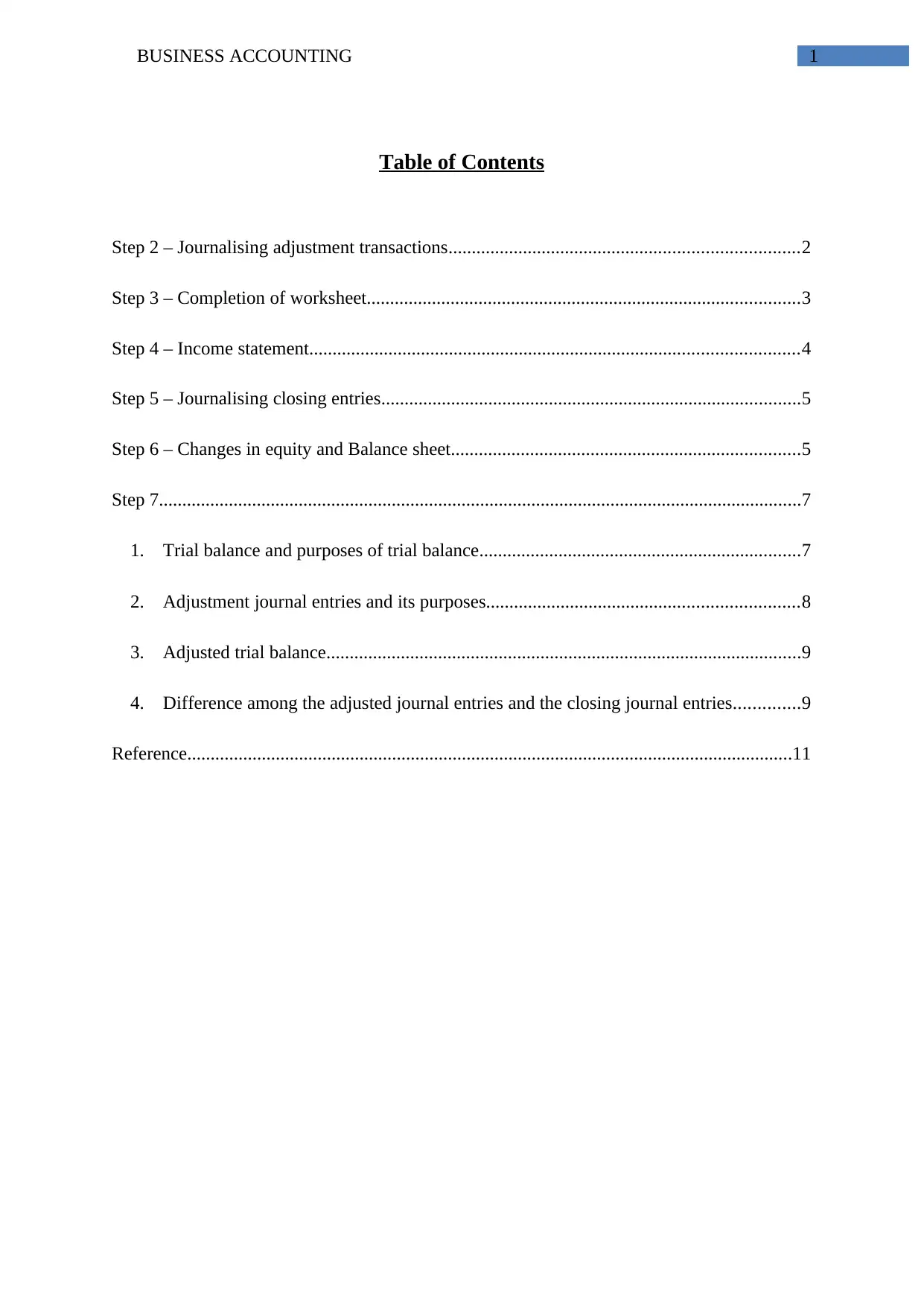
1BUSINESS ACCOUNTING
Table of Contents
Step 2 – Journalising adjustment transactions...........................................................................2
Step 3 – Completion of worksheet.............................................................................................3
Step 4 – Income statement.........................................................................................................4
Step 5 – Journalising closing entries..........................................................................................5
Step 6 – Changes in equity and Balance sheet...........................................................................5
Step 7..........................................................................................................................................7
1. Trial balance and purposes of trial balance.....................................................................7
2. Adjustment journal entries and its purposes...................................................................8
3. Adjusted trial balance......................................................................................................9
4. Difference among the adjusted journal entries and the closing journal entries..............9
Reference..................................................................................................................................11
Table of Contents
Step 2 – Journalising adjustment transactions...........................................................................2
Step 3 – Completion of worksheet.............................................................................................3
Step 4 – Income statement.........................................................................................................4
Step 5 – Journalising closing entries..........................................................................................5
Step 6 – Changes in equity and Balance sheet...........................................................................5
Step 7..........................................................................................................................................7
1. Trial balance and purposes of trial balance.....................................................................7
2. Adjustment journal entries and its purposes...................................................................8
3. Adjusted trial balance......................................................................................................9
4. Difference among the adjusted journal entries and the closing journal entries..............9
Reference..................................................................................................................................11
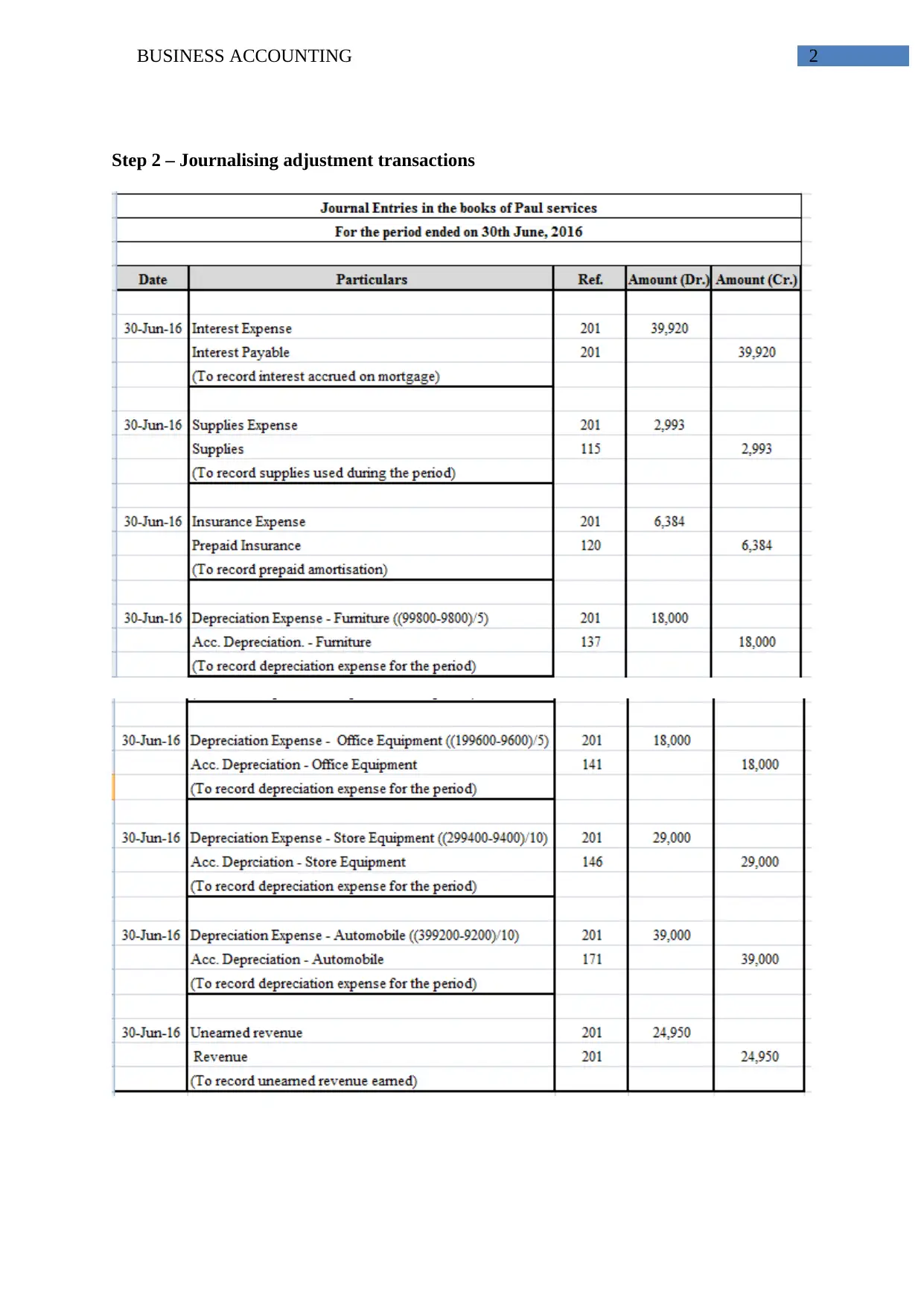
2BUSINESS ACCOUNTING
Step 2 – Journalising adjustment transactions
Step 2 – Journalising adjustment transactions
⊘ This is a preview!⊘
Do you want full access?
Subscribe today to unlock all pages.

Trusted by 1+ million students worldwide
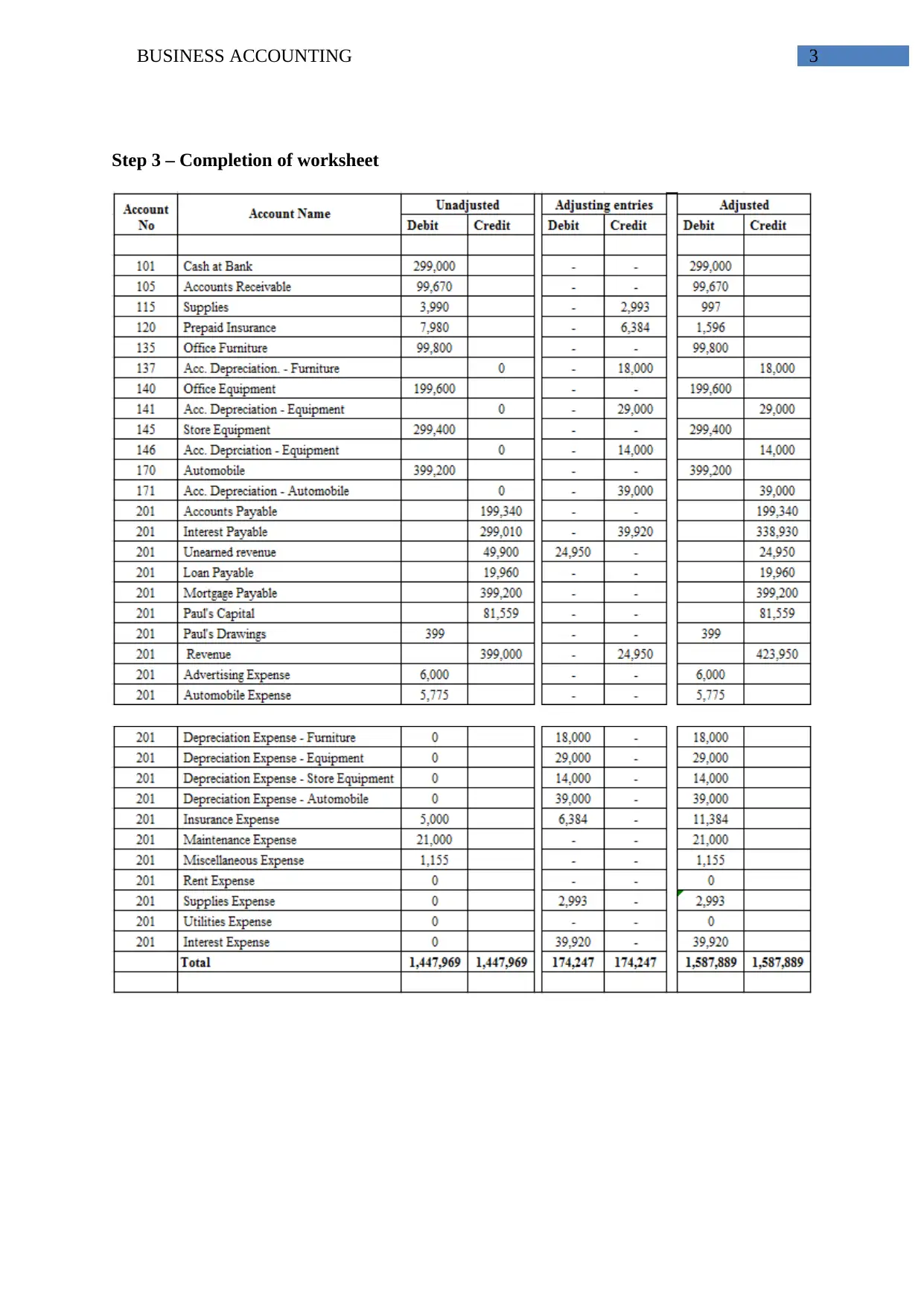
3BUSINESS ACCOUNTING
Step 3 – Completion of worksheet
Step 3 – Completion of worksheet
Paraphrase This Document
Need a fresh take? Get an instant paraphrase of this document with our AI Paraphraser
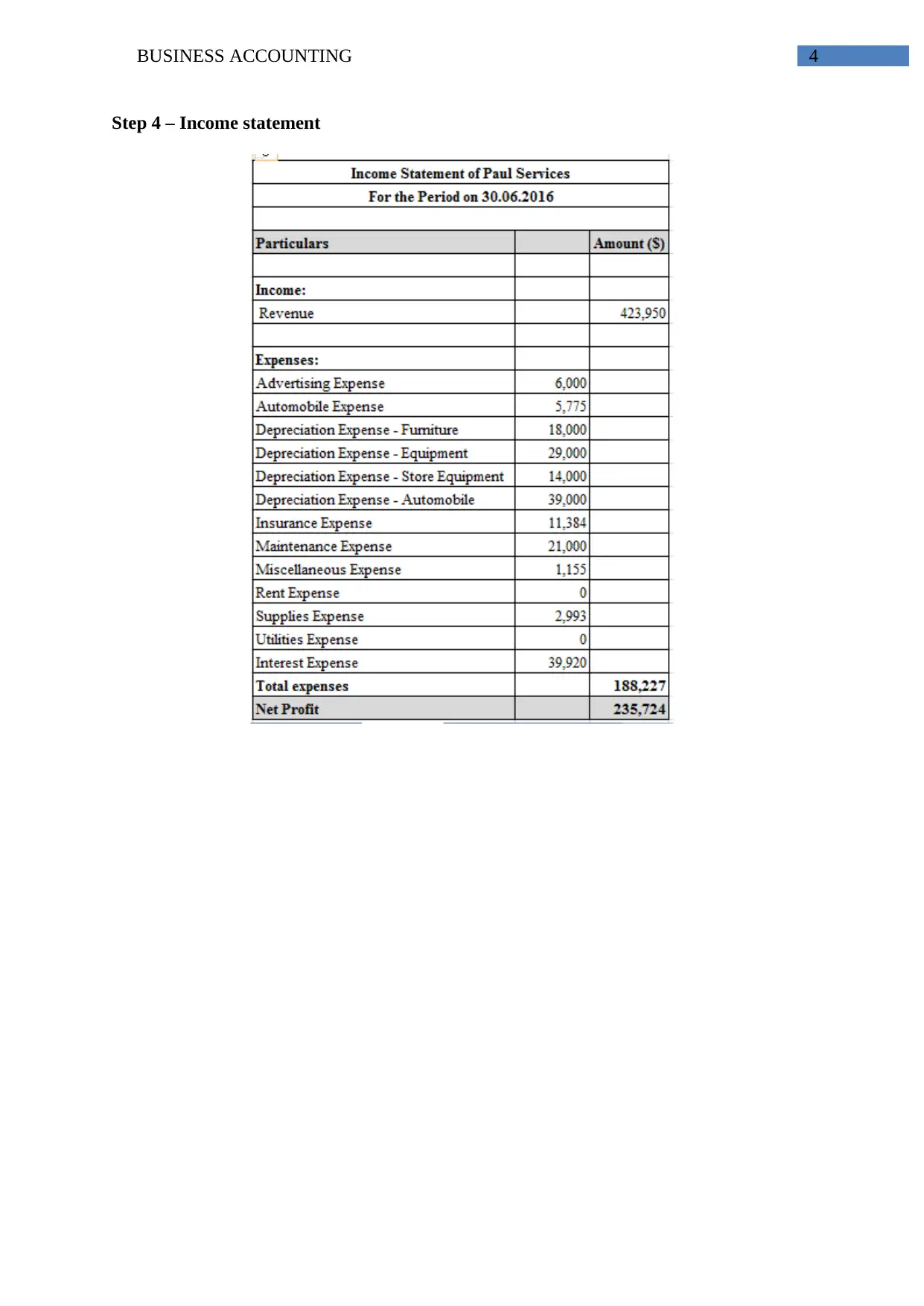
4BUSINESS ACCOUNTING
Step 4 – Income statement
Step 4 – Income statement
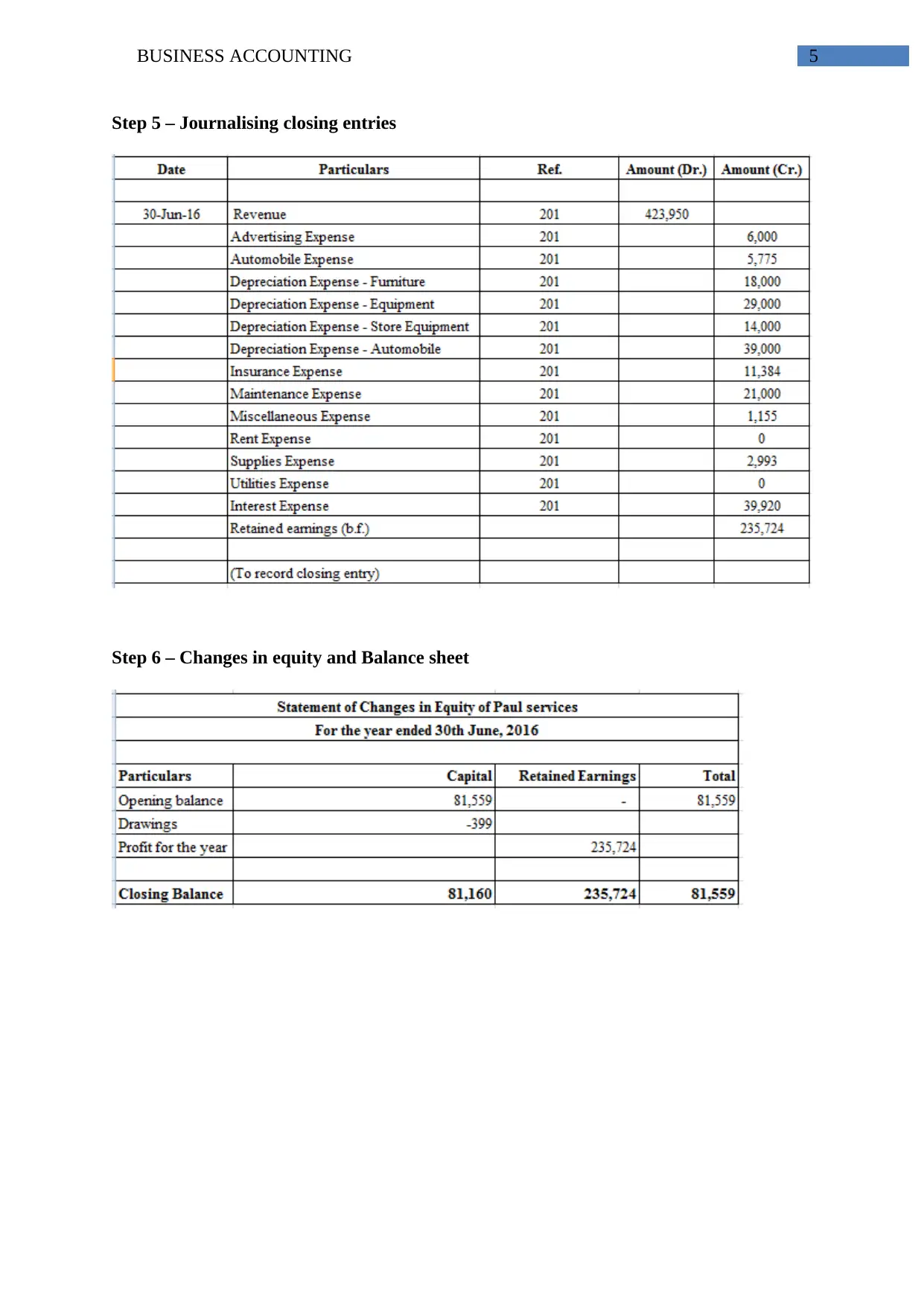
5BUSINESS ACCOUNTING
Step 5 – Journalising closing entries
Step 6 – Changes in equity and Balance sheet
Step 5 – Journalising closing entries
Step 6 – Changes in equity and Balance sheet
⊘ This is a preview!⊘
Do you want full access?
Subscribe today to unlock all pages.

Trusted by 1+ million students worldwide

6BUSINESS ACCOUNTING
Paraphrase This Document
Need a fresh take? Get an instant paraphrase of this document with our AI Paraphraser
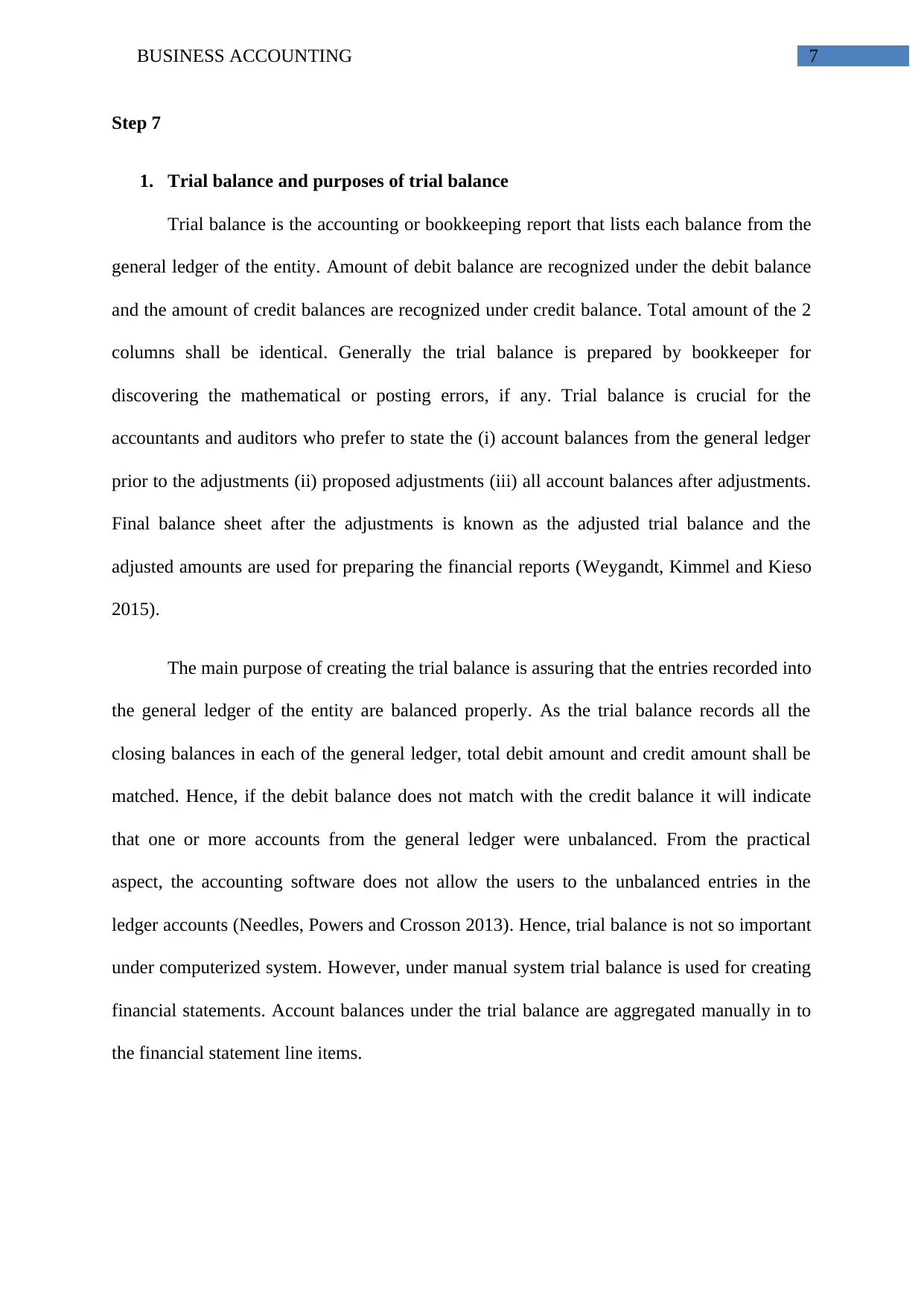
7BUSINESS ACCOUNTING
Step 7
1. Trial balance and purposes of trial balance
Trial balance is the accounting or bookkeeping report that lists each balance from the
general ledger of the entity. Amount of debit balance are recognized under the debit balance
and the amount of credit balances are recognized under credit balance. Total amount of the 2
columns shall be identical. Generally the trial balance is prepared by bookkeeper for
discovering the mathematical or posting errors, if any. Trial balance is crucial for the
accountants and auditors who prefer to state the (i) account balances from the general ledger
prior to the adjustments (ii) proposed adjustments (iii) all account balances after adjustments.
Final balance sheet after the adjustments is known as the adjusted trial balance and the
adjusted amounts are used for preparing the financial reports (Weygandt, Kimmel and Kieso
2015).
The main purpose of creating the trial balance is assuring that the entries recorded into
the general ledger of the entity are balanced properly. As the trial balance records all the
closing balances in each of the general ledger, total debit amount and credit amount shall be
matched. Hence, if the debit balance does not match with the credit balance it will indicate
that one or more accounts from the general ledger were unbalanced. From the practical
aspect, the accounting software does not allow the users to the unbalanced entries in the
ledger accounts (Needles, Powers and Crosson 2013). Hence, trial balance is not so important
under computerized system. However, under manual system trial balance is used for creating
financial statements. Account balances under the trial balance are aggregated manually in to
the financial statement line items.
Step 7
1. Trial balance and purposes of trial balance
Trial balance is the accounting or bookkeeping report that lists each balance from the
general ledger of the entity. Amount of debit balance are recognized under the debit balance
and the amount of credit balances are recognized under credit balance. Total amount of the 2
columns shall be identical. Generally the trial balance is prepared by bookkeeper for
discovering the mathematical or posting errors, if any. Trial balance is crucial for the
accountants and auditors who prefer to state the (i) account balances from the general ledger
prior to the adjustments (ii) proposed adjustments (iii) all account balances after adjustments.
Final balance sheet after the adjustments is known as the adjusted trial balance and the
adjusted amounts are used for preparing the financial reports (Weygandt, Kimmel and Kieso
2015).
The main purpose of creating the trial balance is assuring that the entries recorded into
the general ledger of the entity are balanced properly. As the trial balance records all the
closing balances in each of the general ledger, total debit amount and credit amount shall be
matched. Hence, if the debit balance does not match with the credit balance it will indicate
that one or more accounts from the general ledger were unbalanced. From the practical
aspect, the accounting software does not allow the users to the unbalanced entries in the
ledger accounts (Needles, Powers and Crosson 2013). Hence, trial balance is not so important
under computerized system. However, under manual system trial balance is used for creating
financial statements. Account balances under the trial balance are aggregated manually in to
the financial statement line items.
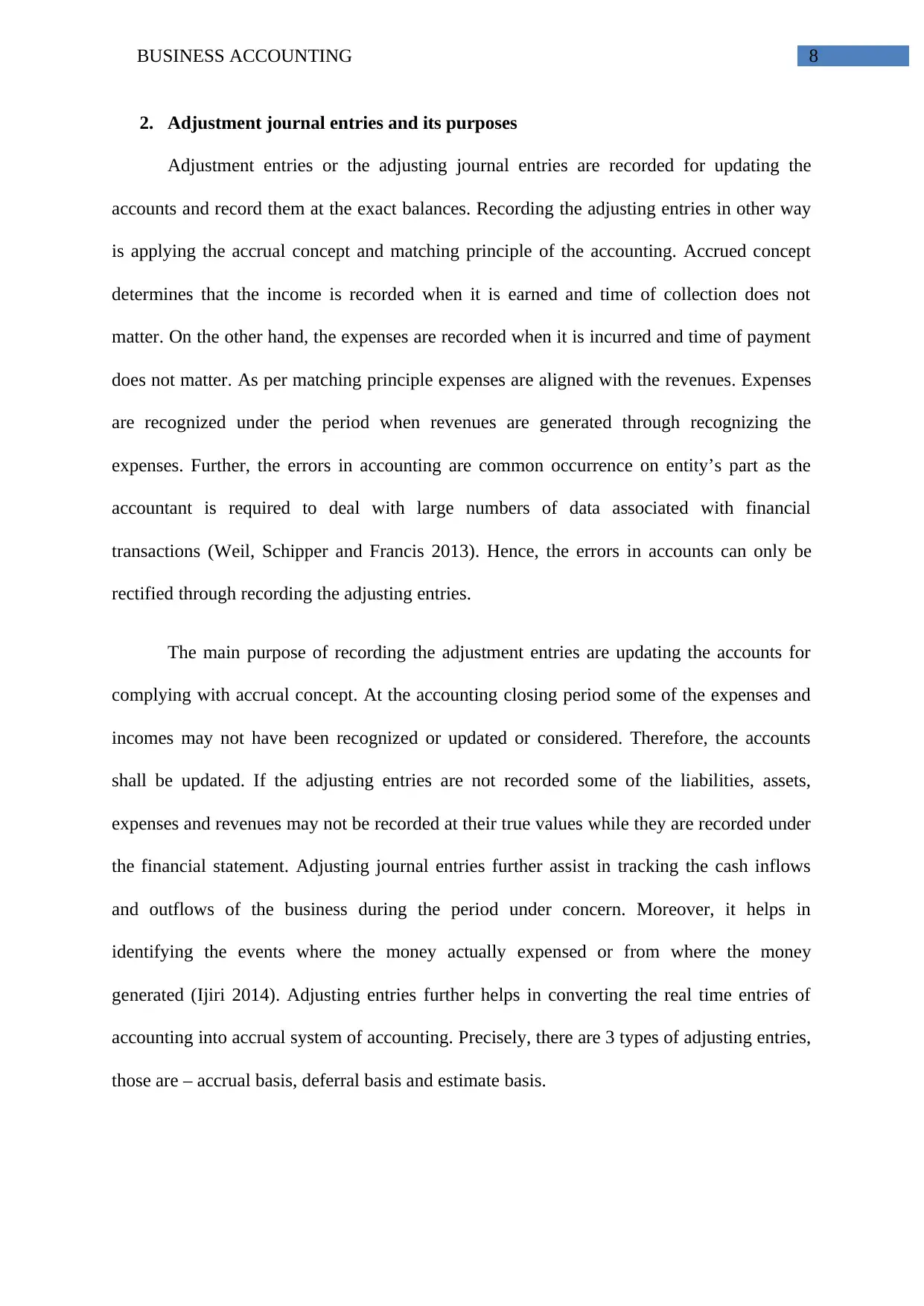
8BUSINESS ACCOUNTING
2. Adjustment journal entries and its purposes
Adjustment entries or the adjusting journal entries are recorded for updating the
accounts and record them at the exact balances. Recording the adjusting entries in other way
is applying the accrual concept and matching principle of the accounting. Accrued concept
determines that the income is recorded when it is earned and time of collection does not
matter. On the other hand, the expenses are recorded when it is incurred and time of payment
does not matter. As per matching principle expenses are aligned with the revenues. Expenses
are recognized under the period when revenues are generated through recognizing the
expenses. Further, the errors in accounting are common occurrence on entity’s part as the
accountant is required to deal with large numbers of data associated with financial
transactions (Weil, Schipper and Francis 2013). Hence, the errors in accounts can only be
rectified through recording the adjusting entries.
The main purpose of recording the adjustment entries are updating the accounts for
complying with accrual concept. At the accounting closing period some of the expenses and
incomes may not have been recognized or updated or considered. Therefore, the accounts
shall be updated. If the adjusting entries are not recorded some of the liabilities, assets,
expenses and revenues may not be recorded at their true values while they are recorded under
the financial statement. Adjusting journal entries further assist in tracking the cash inflows
and outflows of the business during the period under concern. Moreover, it helps in
identifying the events where the money actually expensed or from where the money
generated (Ijiri 2014). Adjusting entries further helps in converting the real time entries of
accounting into accrual system of accounting. Precisely, there are 3 types of adjusting entries,
those are – accrual basis, deferral basis and estimate basis.
2. Adjustment journal entries and its purposes
Adjustment entries or the adjusting journal entries are recorded for updating the
accounts and record them at the exact balances. Recording the adjusting entries in other way
is applying the accrual concept and matching principle of the accounting. Accrued concept
determines that the income is recorded when it is earned and time of collection does not
matter. On the other hand, the expenses are recorded when it is incurred and time of payment
does not matter. As per matching principle expenses are aligned with the revenues. Expenses
are recognized under the period when revenues are generated through recognizing the
expenses. Further, the errors in accounting are common occurrence on entity’s part as the
accountant is required to deal with large numbers of data associated with financial
transactions (Weil, Schipper and Francis 2013). Hence, the errors in accounts can only be
rectified through recording the adjusting entries.
The main purpose of recording the adjustment entries are updating the accounts for
complying with accrual concept. At the accounting closing period some of the expenses and
incomes may not have been recognized or updated or considered. Therefore, the accounts
shall be updated. If the adjusting entries are not recorded some of the liabilities, assets,
expenses and revenues may not be recorded at their true values while they are recorded under
the financial statement. Adjusting journal entries further assist in tracking the cash inflows
and outflows of the business during the period under concern. Moreover, it helps in
identifying the events where the money actually expensed or from where the money
generated (Ijiri 2014). Adjusting entries further helps in converting the real time entries of
accounting into accrual system of accounting. Precisely, there are 3 types of adjusting entries,
those are – accrual basis, deferral basis and estimate basis.
⊘ This is a preview!⊘
Do you want full access?
Subscribe today to unlock all pages.

Trusted by 1+ million students worldwide

9BUSINESS ACCOUNTING
3. Adjusted trial balance
Before stating the purposes of preparing the adjusted trial balance it is required to
understand the concept or meaning of the trial balance. It is the financial statement that is
prepared before preparing various financial reports like income statement, balance sheet and
changes in equity. Preparing adjusted trial balance is recording all the accounting heads and
balances included in general ledger after the adjusting entries are posted for the accounting
period to related accounts. Adjusting entries are the internal documents and are not the
financial statement. It is prepared for assuring that total debit balances matches with the total
credit balance in general ledger (Adejare 2014). Hence, if the debit balance does not match
with the credit balance it will indicate that one or more accounts from the general ledger were
unbalanced.
Main objective of preparing the adjusted trial balance is assuring that all the ledgers
are entered correctly as per the accounting equation which in turn will make the financial
report mathematically correct. Further, it is prepared to identify and detect the errors, if any in
the general ledger. Trial balance is also used as working papers for the auditors and
accountants while drafting the financial statements. Another main objective behind preparing
the adjusted trial balance is preparing the correct financial statements (Edmonds et al. 2013).
Primary objective of preparing the financial statement is helping the users with decision
making procedure. Hence, if the financial reports are not prepared correctly it will mislead
the users in decision making process.
4. Difference among the adjusted journal entries and the closing journal entries
Adjusting entries are recorded in the accounting journals at the closing of the
accounting period after preparing the trial balance. Major purpose of the adjusting entries is
adjusting the expenses and revenue under the accounting period under which they took place.
Conversely, the closing entries are considered as the journal entries recorded while closing
3. Adjusted trial balance
Before stating the purposes of preparing the adjusted trial balance it is required to
understand the concept or meaning of the trial balance. It is the financial statement that is
prepared before preparing various financial reports like income statement, balance sheet and
changes in equity. Preparing adjusted trial balance is recording all the accounting heads and
balances included in general ledger after the adjusting entries are posted for the accounting
period to related accounts. Adjusting entries are the internal documents and are not the
financial statement. It is prepared for assuring that total debit balances matches with the total
credit balance in general ledger (Adejare 2014). Hence, if the debit balance does not match
with the credit balance it will indicate that one or more accounts from the general ledger were
unbalanced.
Main objective of preparing the adjusted trial balance is assuring that all the ledgers
are entered correctly as per the accounting equation which in turn will make the financial
report mathematically correct. Further, it is prepared to identify and detect the errors, if any in
the general ledger. Trial balance is also used as working papers for the auditors and
accountants while drafting the financial statements. Another main objective behind preparing
the adjusted trial balance is preparing the correct financial statements (Edmonds et al. 2013).
Primary objective of preparing the financial statement is helping the users with decision
making procedure. Hence, if the financial reports are not prepared correctly it will mislead
the users in decision making process.
4. Difference among the adjusted journal entries and the closing journal entries
Adjusting entries are recorded in the accounting journals at the closing of the
accounting period after preparing the trial balance. Major purpose of the adjusting entries is
adjusting the expenses and revenue under the accounting period under which they took place.
Conversely, the closing entries are considered as the journal entries recorded while closing
Paraphrase This Document
Need a fresh take? Get an instant paraphrase of this document with our AI Paraphraser
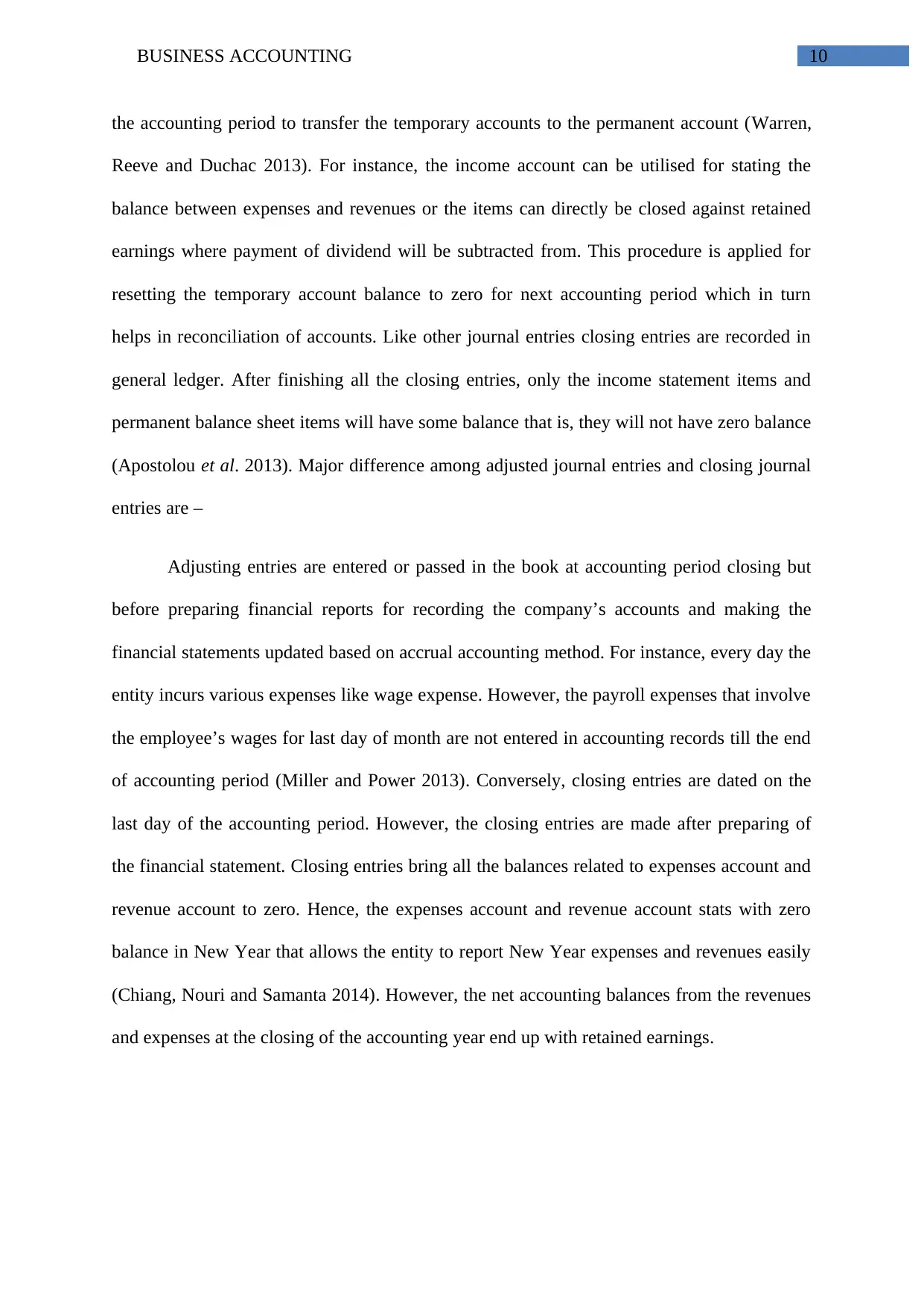
10BUSINESS ACCOUNTING
the accounting period to transfer the temporary accounts to the permanent account (Warren,
Reeve and Duchac 2013). For instance, the income account can be utilised for stating the
balance between expenses and revenues or the items can directly be closed against retained
earnings where payment of dividend will be subtracted from. This procedure is applied for
resetting the temporary account balance to zero for next accounting period which in turn
helps in reconciliation of accounts. Like other journal entries closing entries are recorded in
general ledger. After finishing all the closing entries, only the income statement items and
permanent balance sheet items will have some balance that is, they will not have zero balance
(Apostolou et al. 2013). Major difference among adjusted journal entries and closing journal
entries are –
Adjusting entries are entered or passed in the book at accounting period closing but
before preparing financial reports for recording the company’s accounts and making the
financial statements updated based on accrual accounting method. For instance, every day the
entity incurs various expenses like wage expense. However, the payroll expenses that involve
the employee’s wages for last day of month are not entered in accounting records till the end
of accounting period (Miller and Power 2013). Conversely, closing entries are dated on the
last day of the accounting period. However, the closing entries are made after preparing of
the financial statement. Closing entries bring all the balances related to expenses account and
revenue account to zero. Hence, the expenses account and revenue account stats with zero
balance in New Year that allows the entity to report New Year expenses and revenues easily
(Chiang, Nouri and Samanta 2014). However, the net accounting balances from the revenues
and expenses at the closing of the accounting year end up with retained earnings.
the accounting period to transfer the temporary accounts to the permanent account (Warren,
Reeve and Duchac 2013). For instance, the income account can be utilised for stating the
balance between expenses and revenues or the items can directly be closed against retained
earnings where payment of dividend will be subtracted from. This procedure is applied for
resetting the temporary account balance to zero for next accounting period which in turn
helps in reconciliation of accounts. Like other journal entries closing entries are recorded in
general ledger. After finishing all the closing entries, only the income statement items and
permanent balance sheet items will have some balance that is, they will not have zero balance
(Apostolou et al. 2013). Major difference among adjusted journal entries and closing journal
entries are –
Adjusting entries are entered or passed in the book at accounting period closing but
before preparing financial reports for recording the company’s accounts and making the
financial statements updated based on accrual accounting method. For instance, every day the
entity incurs various expenses like wage expense. However, the payroll expenses that involve
the employee’s wages for last day of month are not entered in accounting records till the end
of accounting period (Miller and Power 2013). Conversely, closing entries are dated on the
last day of the accounting period. However, the closing entries are made after preparing of
the financial statement. Closing entries bring all the balances related to expenses account and
revenue account to zero. Hence, the expenses account and revenue account stats with zero
balance in New Year that allows the entity to report New Year expenses and revenues easily
(Chiang, Nouri and Samanta 2014). However, the net accounting balances from the revenues
and expenses at the closing of the accounting year end up with retained earnings.
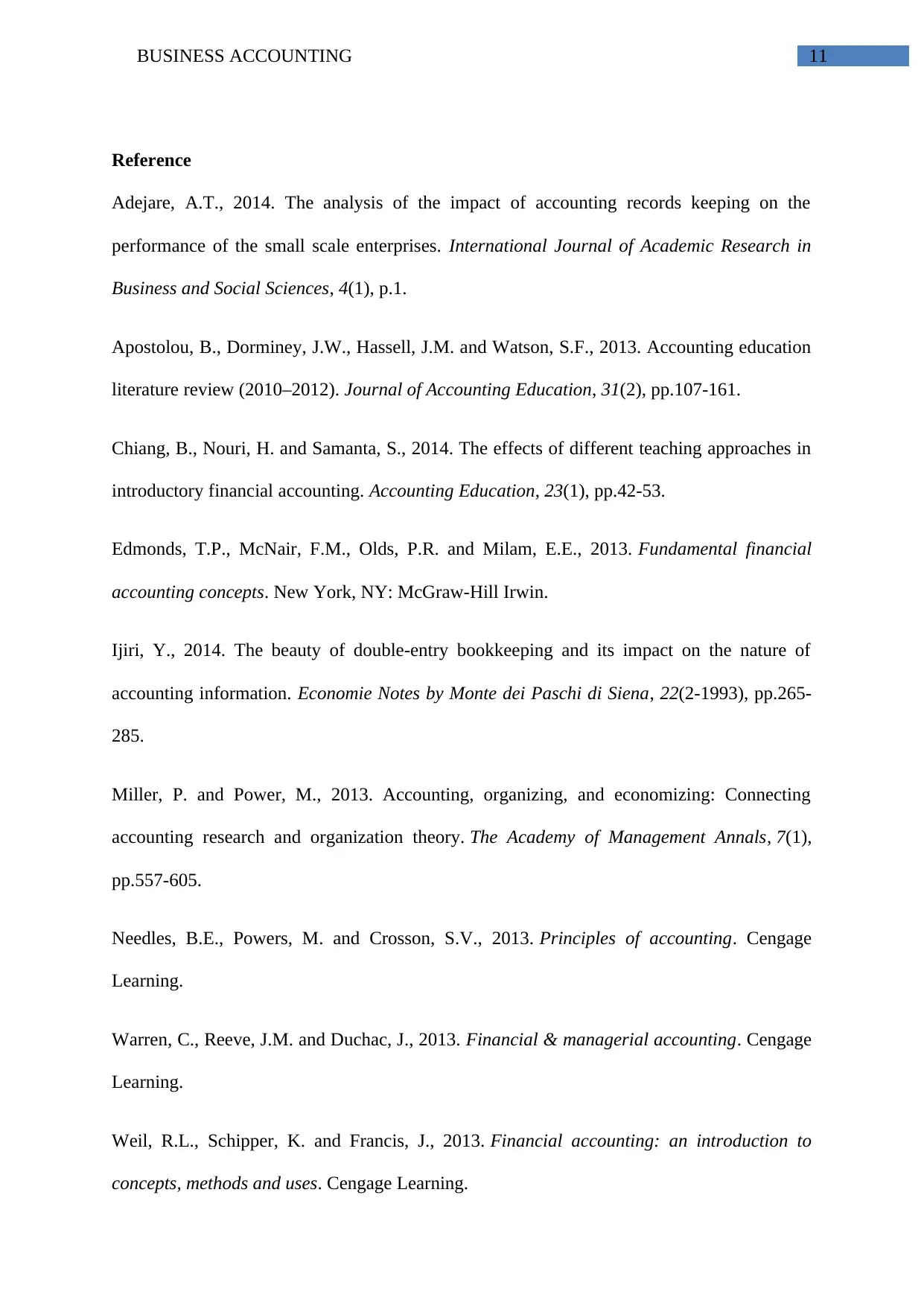
11BUSINESS ACCOUNTING
Reference
Adejare, A.T., 2014. The analysis of the impact of accounting records keeping on the
performance of the small scale enterprises. International Journal of Academic Research in
Business and Social Sciences, 4(1), p.1.
Apostolou, B., Dorminey, J.W., Hassell, J.M. and Watson, S.F., 2013. Accounting education
literature review (2010–2012). Journal of Accounting Education, 31(2), pp.107-161.
Chiang, B., Nouri, H. and Samanta, S., 2014. The effects of different teaching approaches in
introductory financial accounting. Accounting Education, 23(1), pp.42-53.
Edmonds, T.P., McNair, F.M., Olds, P.R. and Milam, E.E., 2013. Fundamental financial
accounting concepts. New York, NY: McGraw-Hill Irwin.
Ijiri, Y., 2014. The beauty of double-entry bookkeeping and its impact on the nature of
accounting information. Economie Notes by Monte dei Paschi di Siena, 22(2-1993), pp.265-
285.
Miller, P. and Power, M., 2013. Accounting, organizing, and economizing: Connecting
accounting research and organization theory. The Academy of Management Annals, 7(1),
pp.557-605.
Needles, B.E., Powers, M. and Crosson, S.V., 2013. Principles of accounting. Cengage
Learning.
Warren, C., Reeve, J.M. and Duchac, J., 2013. Financial & managerial accounting. Cengage
Learning.
Weil, R.L., Schipper, K. and Francis, J., 2013. Financial accounting: an introduction to
concepts, methods and uses. Cengage Learning.
Reference
Adejare, A.T., 2014. The analysis of the impact of accounting records keeping on the
performance of the small scale enterprises. International Journal of Academic Research in
Business and Social Sciences, 4(1), p.1.
Apostolou, B., Dorminey, J.W., Hassell, J.M. and Watson, S.F., 2013. Accounting education
literature review (2010–2012). Journal of Accounting Education, 31(2), pp.107-161.
Chiang, B., Nouri, H. and Samanta, S., 2014. The effects of different teaching approaches in
introductory financial accounting. Accounting Education, 23(1), pp.42-53.
Edmonds, T.P., McNair, F.M., Olds, P.R. and Milam, E.E., 2013. Fundamental financial
accounting concepts. New York, NY: McGraw-Hill Irwin.
Ijiri, Y., 2014. The beauty of double-entry bookkeeping and its impact on the nature of
accounting information. Economie Notes by Monte dei Paschi di Siena, 22(2-1993), pp.265-
285.
Miller, P. and Power, M., 2013. Accounting, organizing, and economizing: Connecting
accounting research and organization theory. The Academy of Management Annals, 7(1),
pp.557-605.
Needles, B.E., Powers, M. and Crosson, S.V., 2013. Principles of accounting. Cengage
Learning.
Warren, C., Reeve, J.M. and Duchac, J., 2013. Financial & managerial accounting. Cengage
Learning.
Weil, R.L., Schipper, K. and Francis, J., 2013. Financial accounting: an introduction to
concepts, methods and uses. Cengage Learning.
⊘ This is a preview!⊘
Do you want full access?
Subscribe today to unlock all pages.

Trusted by 1+ million students worldwide
1 out of 13
Related Documents
Your All-in-One AI-Powered Toolkit for Academic Success.
+13062052269
info@desklib.com
Available 24*7 on WhatsApp / Email
![[object Object]](/_next/static/media/star-bottom.7253800d.svg)
Unlock your academic potential
Copyright © 2020–2025 A2Z Services. All Rights Reserved. Developed and managed by ZUCOL.





